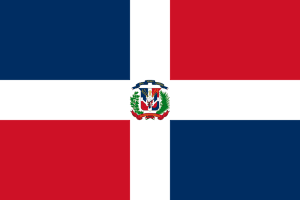
| Colors | HEX Code | RGB | CMYK |
|---|---|---|---|
| Blue | #002D62 | 0, 45, 98 | 100, 54, 0, 62 |
| Red | #CE1126 | 206, 17, 38 | 0, 92, 82, 19 |
| White | #FFFFFF | 255, 255, 255 | 0, 0, 0, 0 |
| Green | #016503 | 1, 101, 3 | 99, 0, 97, 60 |
| Yellow | #E0B805 | 224, 184, 5 | 0, 18, 98, 12 |
The Dominican Republic Flag features a centered white cross that divides the flag into four rectangles—two blue and two red. The blue rectangles are situated at the top and bottom, while the red ones occupy the left and right sides. In the center of the flag, there is the national coat of arms. The coat of arms incorporates the national flag, a Bible, a cross, and branches of laurel and palm. It also has the name of the country, and the motto “Dios, patria, libertad” (“God, fatherland, liberty”).
Meaning of the Dominican flag
The blue stands for liberty, while the white color is for salvation. The red is a symbol for the heroes of the Dominican Republic.
History of the Dominican Republic flag
The Dominican Republic was owned by the Spanish Monarchy until the 17 century when France colonized the western part of the island and named it Saint-Domingue. The French colony later became Haiti, which was established in the 1800s. The Eastern part of the island which belonged to Spain was conquered by Haiti in 1822, when Haiti was a newly independent republic. The Haiti flag had horizontal stripes of blue and red, and it was the basis of the Dominican Republic flag later on. The revolution of 1844 placed the white cross to emphasize the Christian identity of the island. As the Dominican Republic proclaimed its independence, The stripes were reversed so that the rectangles would be of alternating colors. The official flag was hoisted on November 6, 1844.